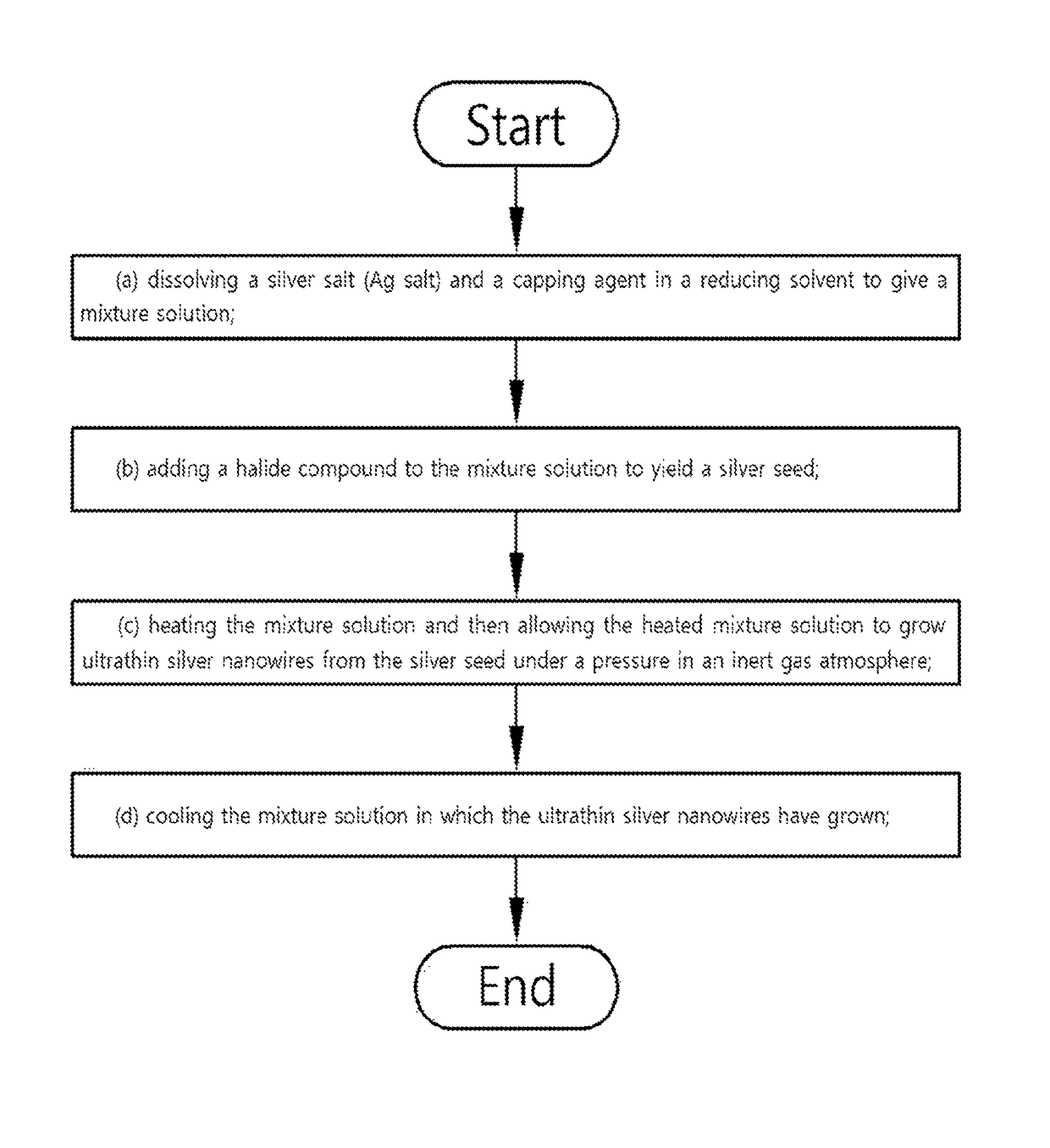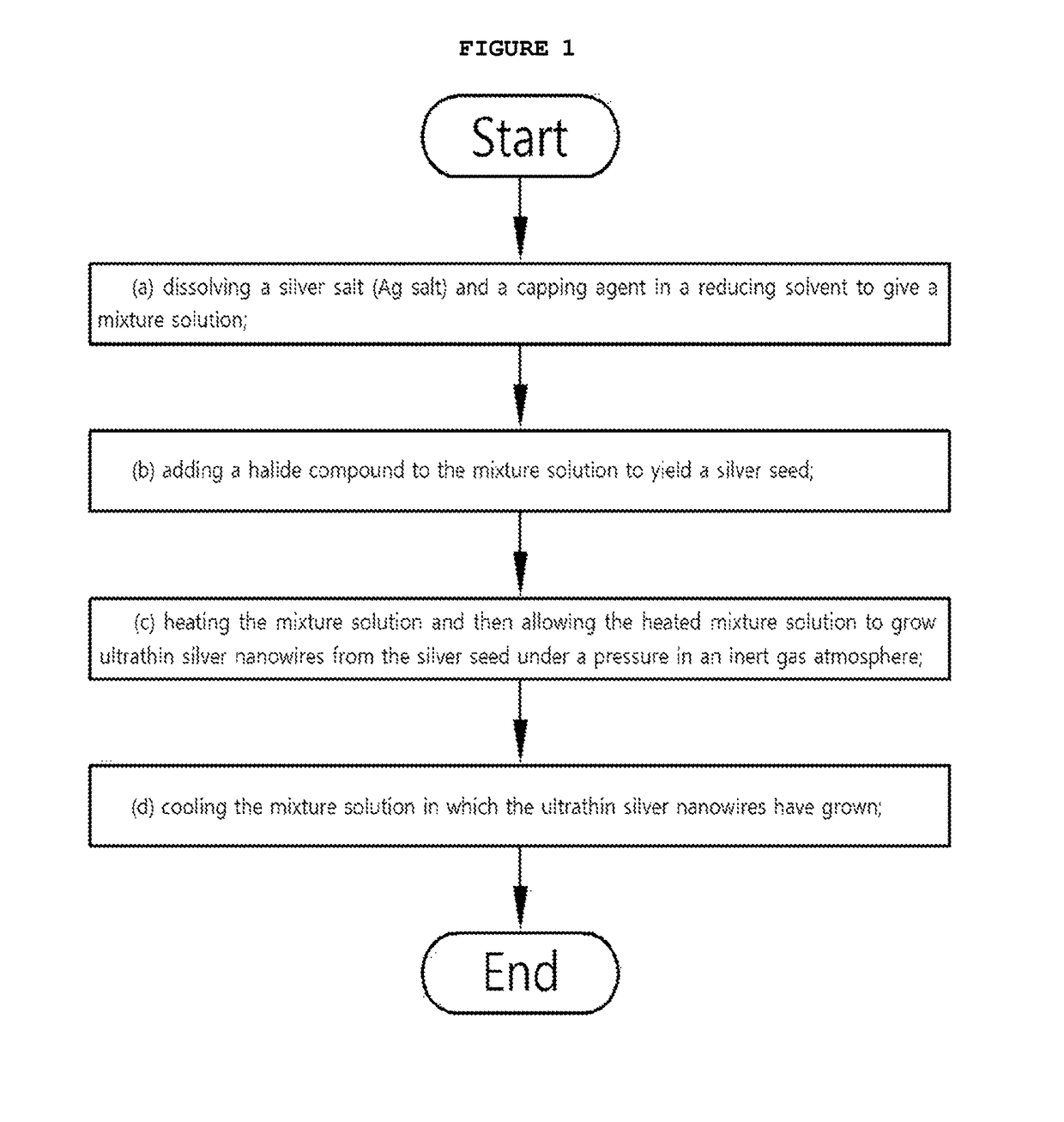Method for preparing ultrathin silver nanowires, and transparent conductive electrode film product thereof
a technology of conductive electrode film and ultrathin silver nanowires, which is applied in the direction of non-metal conductors, conductors, transportation and packaging, etc., can solve the problems of poor chemical and thermal stability, low conductivity, and high light absorption. achieve the effect of improving the aspect ratio
- Summary
- Abstract
- Description
- Claims
- Application Information
AI Technical Summary
Benefits of technology
Problems solved by technology
Method used
Image
Examples
example 1-1
[0123]In Example 1-1, 0.56 g of polyvinylpyrrolidone (PVP, Mw: 1,300,000), and 0.48 g of silver nitrate (AgNO3) were dissolved in 60 mL of ethylene glycol, and introduced into a hydrothermal reactor to which a solution containing 0.025 g of NaCl and 0.045 g of KBr in 50 mL of ethylene glycol was then added.
[0124]Subsequently, the mixture was heated to 150° C. while stirring. Once nanoparticle-type silver seeds with a size of 100 nm were formed, a pressure of 50 psi was applied to the solution for 70 min in a nitrogen (N2) atmosphere to induce the seeds to selectively grow in the (110) direction.
[0125]Thereafter, the solution was cooled to 4 to 25° C. A phase separation was made with acetone, and the supernatant thus formed was removed because ethylene glycol, silver nanoparticles and polyvinylpyrrolidone were dispersed therein. After this process was repeated three times, the ultrathin silver nanowires thus purified were dispersed in 30 mL of distilled water.
[0126]FIG. 4 is an SEM (...
example 1-2
[0128]Silver nanowires were prepared in the same manner as in Example 1-1, with the exception that a solution of polyvinylpyrrolidone, silver nitrate, NaCl and KBr in ethylene glycol was pressurized under a pressure of 100 psi for 60 min in a nitrogen (N2) atmosphere.
[0129]FIG. 5 is an SEM image of the ultrathin silver nanowires prepared in Example 1-2.
[0130]FIG. 6 is a magnified SEM image of the ultrathin silver nanowires prepared in Example 1-2.
[0131]As shown in FIGS. 5 and 6, the ultrathin silver nanowires prepared in Example 1-2 had a diameter of approximately 20 nm to 22 nm, with an aspect ratio of approximately 400 to 500, indicating that they were significantly restrained from growing in a thickness-wise direction and were more homogeneous in diameter, compared to conventional silver nanowires having an average diameter of 40 nm to 80 nm.
example 1-3
[0132]Silver nanowires were prepared in the same manner as in Example 1-1, with the exception that a solution of polyvinylpyrrolidone, silver nitrate, NaCl and KBr in ethylene glycol was pressurized under a pressure of 400 psi for 50 min in a nitrogen (N2) atmosphere.
[0133]The ultrathin silver nanowires prepared in Example 1-3 had a diameter of approximately 12 nm to 15 nm, with an aspect ratio of approximately 300 to 350, indicating that they were significantly restrained from growing in thickness and were homogeneous in diameter. In addition, the silver nanowires were observed to measure approximately 15 μm in length on average.
PUM
| Property | Measurement | Unit |
|---|---|---|
| pressure | aaaaa | aaaaa |
| pressure | aaaaa | aaaaa |
| pressure | aaaaa | aaaaa |
Abstract
Description
Claims
Application Information
 Login to View More
Login to View More - R&D
- Intellectual Property
- Life Sciences
- Materials
- Tech Scout
- Unparalleled Data Quality
- Higher Quality Content
- 60% Fewer Hallucinations
Browse by: Latest US Patents, China's latest patents, Technical Efficacy Thesaurus, Application Domain, Technology Topic, Popular Technical Reports.
© 2025 PatSnap. All rights reserved.Legal|Privacy policy|Modern Slavery Act Transparency Statement|Sitemap|About US| Contact US: help@patsnap.com



